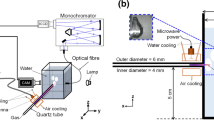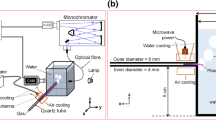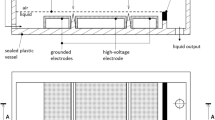Abstract
Electrical discharge plasma formed in liquid water is under intensive investigation for many possible applications in biomedical, environmental and chemical engineering as well as for general scientific issues in plasma chemistry and other engineering applications. The subject of pulsed breakdown of water has additionally begun to assume importance due to growing interest in decontamination, purification of water containing chemical impurities and industrial sludge, and also in the emerging area of bio-electrics. This review paper focuses on the plasma physics (Part I) and chemistry of electrical discharges in liquid water and the chemical effects of plasmas on the degradation of organic molecules (Part II). This part discusses dielectric liquid breakdown and its mechanisms, streamer propagation and the effect of electrode polarity on streamer dynamics.






Similar content being viewed by others
References
Locke BR, Sato M, Sunka P, Hoffmann MR, Chang JS (2006) Electrohydraulic discharge and nonthermal plasma for water treatment. Ind Eng Chem Res 45(3):882–905
Akiyama H (2000) Streamer discharges in liquids and their applications. IEEE Trans Dielectr Electr Insul 7(5):646–653
Malik MA, Ghaffar A, Malik SA (2001) Water purification by electrical discharges. Plasma Sour Sci Technol 10(1):82–91
Sunka P (2001) Pulse electrical discharges in water and their applications. Phys Plasmas 8(5):2587–2594
Bruggeman P, Leys C (2009) Non-thermal plasmas in and in contact with liquids. J Phys D Appl Phys 42(5):053001–053012
Brisset J-L, Moussa D, Doubla A, Hnatiuc E, Hnatiuc B, Kamgang Youbi G, Herry J-M, Naitali M, Bellon-Fontaine M-N (2008) Chemical reactivity of discharges and temporal post-discharges in plasma treatment of aqueous media: Examples of gliding discharge treated solutions. Ind Eng Chem Res 47(16):5761–5781
Chang J-S (2001) Recent development of plasma pollution control technology: a critical review. Sci Technol Adv Mater 2(3–4):571–581
Schoenbach KH, Joshi RP, Stark RH, Dobbs FC, Beebe SJ (2000) Bacterial decontamination of liquids with pulsed electric fields. IEEE Trans Dielectr Electr Insul 7(5):637–645
Abou-Ghazala A, Katsuki S, Schoenbach KH, Dobbs FC, Moreira KR (2002) Bacterial decontamination of water by means of pulsed-corona discharges. IEEE Trans Plasma Sci 30(4):1449–1453
Bystritskii VM, Wood TK, Yankelevich Y, Chauhan S, Yee D, Wessel F (1997) Pulsed power for advanced waste water remediation. In: 11th IEEE international pulsed power conference, 29 Jun–2 Jul 1997. pp 79–84
Lisitsyn IV, Nomiyama H, Katsuki S, Akiyama H (1999) Streamer discharge reactor for water treatment by pulsed power. Rev Sci Instrum 70(8):3457–3462
Schoenbach KH, Shu X, Joshi RP, Camp JT, Heeren T, Kolb JF, Beebe SJ (2008) The effect of intense subnanosecond electrical pulses on biological cells. IEEE Trans Plasma Sci 36(2):414–422
Schoenbach KH, Joshi RP, Kolb JF, Chen NY, Stacey M, Blackmore PF, Buescher ES, Beebe SJ (2004) Ultrashort electrical pulses open a new gateway into biological cells. Proc IEEE 92(7):1122–1137
Buntzen RR (1962) The use of exploding wires in the study of small-scale underwater explosions. In: Chace WG, Moore HK (eds) Exploding wires. Plenum Press, New York
Smith KF (1964) Electro-hydraulic forming. In: Wilson FW (ed) High-velocity forming of metals. Prentice Hall, Englewood Cliffs, NJ
Sunka P, Babicky V, Clupek M, Stuka C (1995) New discharge circuit for efficient shock wave generation. In: Brun R, Dumitrescu Z (eds) Shock waves at Marseille III. Springer, Berlin
Howard D, Sturtevant B (1997) In vitro study of the mechanical effects of shock-wave lithotripsy. Ultrasound Med Biol 23(7):1107–1122
Malik MA, Ahmed M, E-u-R Ejaz-ur-Rehman, Naheed R, Ghaffar A (2003) Synthesis of superabsorbent copolymers by pulsed corona discharges in water. Plasma Polym 8(4):271–279
Woloszko J, Stalder KR, Brown IG (2002) Plasma characteristics of repetitively-pulsed electrical discharges in saline solutions used for surgical procedures. IEEE Trans Plasma Sci 30(3):1376–1383
Stalder KR, Woloszko J, Brown IG, Smith CD (2001) Repetitive plasma discharges in saline solutions. Appl Phys Lett 79(27):4503–4505
Koh IO, Wohlers J, Thiemann W, Rotard W (2009) Application of an air ionization device using an atmospheric pressure corona discharge process for water purification. Water Air Soil Pollut 196(1–4):101–113
Gerrity D, Stanford BD, Trenholm RA, Snyder SA (2010) An evaluation of a pilot-scale nonthermal plasma advanced oxidation process for trace organic compound degradation. Water Res 44(2):493–504
Mededovic S, Finney WC, Locke BR (2007) Aqueous-phase mineralization of s-triazine using pulsed electrical discharge. IJPEST 1(1):82–90
Mededovic S, Locke BR (2007) Side-chain degradation of atrazine by pulsed electrical discharge in water. Ind Eng Chem Res 46(9):2702–2709
Pereira RN, Vicente AA (2010) Environmental impact of novel thermal and non-thermal technologies in food processing. Food Res Int 43(7):1936–1943
Sunka P, Babicky V, Clupek M, Lukes P, Simek M, Schmidt J, Cernak M (1999) Generation of chemically active species by electrical discharges in water. Plasma Sour Sci Trans 8(2):258–265
Lukes P, Clupek M, Sunka P, Babicky V, Janda V (2002) Effect of ceramic composition on pulse discharge induced processes in water using ceramic-coated wire to cylinder electrode system. Czech J Phys 52:800–806
Malik MA, Minamitani Y, Xiao S, Kolb JF, Schoenbach KH (2005) Streamers in water filled wire-cylinder and packed-bed reactors. IEEE Trans Plasma Sci 33(2):490–491
Grymonpre DR, Finney WC, Clark RJ, Locke BR (2004) Hybrid gas−liquid electrical discharge reactors for organic compound degradation. Ind Eng Chem Res 43(9):1975–1989
Sahni M, Locke BR (2006) Degradation of chemical warfare agent stimulants using gas−liquid pulsed streamer discharges. J Hazard Mater 137(2):1025–1034
Malik MA, Ghaffar A, Malik SA (2001) Water purification by electrical discharges. Plasma Sour Sci Trans 10(1):82–91
Bruggeman P, Leys C, Gromov SP (2009) Generation mechanisms and physical properties of electrical discharges in and above water. In: Gromov SP (ed) Plasma physics research advances. Nova Publishers, Berlin
Bluhm H (2006) Pulsed power systems: principles and applications. Springer, Berlin
Manolache S, Somers EB, Wong ACL, Shamamian V, Denes F (2001) Dense medium plasma environments: a new approach for the disinfection of water. Environ Sci Technol 35(18):3780–3785
Baroch P, Potocky S, Saito N (2011) Generation of plasmas in water: utilization of a high-frequency, low-voltage bipolar pulse power supply with impedance control. Plasma Sources Sci Trans 20(3):034017–034025
Lukes P, Clupek M, Babicky V, Sunka P (2009) The role of surface chemistry at ceramic/electrolyte interfaces in the generation of pulsed corona discharges in water using porous ceramic-coated rod electrodes. Plasma Process Polym 6(11):719–728
Mukasa S, Nomura S, Toyota H, Maehara T, Yamashita H (2011) Internal conditions of a bubble containing radio-frequency plasma in water. Plasma Sour Sci Trans 20(3):034020–034032
Ishijima T, Sugiura H, Saito R, Toyoda H, Sugai H (2010) Efficient production of microwave bubble plasma in water for plasma processing in liquid. Plasma Sour Sci Trans 19(1):015010–015020
Lewis TJ (1998) A new model for the primary process of electrical breakdown in liquids. IEEE Trans Dielectr Electr Insul 5(3):306–315
Joshi RP, Qian J, Schoenbach KH, Schamiloglu E (2004) Microscopic analysis for water stressed by high electric fields in the prebreakdown regime. J Appl Phys 96(7):3617–3625
Cheng H-H, Chen S-S, Wu Y-C, Ho D-L (2007) Non-thermal plasma technology for degradation of organic compounds in wastewater. J Environ Eng Manage 17(6):427–433
Schmidt WF (1997) Liquid state electronics of insulating liquids. CRC Press, Boca Raton
Lewis TJ (1987) Dielectric breakdown of liquids. In: EE Kunhardt, LG Christophorou, LH Luessen (ed) The liquid state and its electrical properties (NATO Advanced Study Institute, Series B: Physics vol 193), vol 193. Plenum Press, New York
Kolb JF, Joshi RP, Xiao S, Schoenbach KH (2008) Streamers in water and other dielectric liquids. J Phys D Appl Phys 41(23):234007–234015
Joshi RP, Kolb JF, Xiao S, Schoenbach KH (2009) Aspects of plasma in water: streamer physics and applications. Plasma Process Polym 6(11):763–777
Liao TW, Anderson JG (1953) Propagation mechanism of impulse corona and breakdown in oil. Trans Am Inst Electr Eng 72:641–648
Stekol’nikov IS, Ushakov VY (1966) Discharge phenomena in liquids. Sov Phys Tech Phys 10(9):1307–1313
Devins JC, Rzad SJ, Schwabe RJ (1981) Breakdown and prebreakdown phenomena in liquids. J Appl Phys 52:4531–4546
Sharbaugh AH, Devins JC, Rzad SJ (1978) Progress in the field of electric breakdown in dielectric liquids. IEEE Trans Electr Insul 13(4):249–276
Tobazeon R (1994) Prebreakdown phenomena in dielectric liquids. IEEE Trans Dielectr Electr Insul 1(6):1132–1147
Felici NJ (1988) Blazing a fiery trail with the hounds (prebreakdown streamers). IEEE Trans Electr Insul 23(4):497–503
Laenen R, Roth T, Laubereau A (2000) Novel precursors of solvated electrons in water: evidence for a charge transfer process. Phys Rev Lett 85(1):50–53
Olson AH, Sutton SP (1993) The physical mechanisms leading to electrical breakdown in underwater arc sound sources. J Acoust Soc Am 94(4):2226–2231
Touya G, Reess T, Pécastaing L, Gibert A, Domens P (2006) Development of subsonic electrical discharges in water and measurements of the associated pressure waves. J Phys D Appl Phys 39(24):5236–5247
Lisitsyn IV, Nomiyama H, Katsuki S, Akiyama H (1999) Thermal processes in a streamer discharge in water. IEEE Trans Dielectr Electr Insul 6(3):351–356
Butcher M, Neuber AA, Cevallos MD, Dickens JC, Krompholz H (2006) Conduction and breakdown mechanisms in transformer oil. IEEE Trans Plasma Sci 34(2):467–475
Castellanos A, Pontiga F (1995) Generalised Thomson–Onsager model for charge injection into dielectric liquids. In: 1995 Conference on electrical insulation and dielectric phenomena, 22–25 Oct 1995. pp 616–620
Leipold F, Yu G, Stark RH, Abou-Ghazala A, Schoenbach KH (2000) Studies on the temporal development of electrical breakdown in water. In: Conference record of the 2000 twenty-fourth international power modulator symposium, 26–29 June 2000. pp 51–54
Korobeinikov SM, Melekhov AV, Besov AS (2002) Breakdown initiation in water with the aid of bubbles. High Temp 40(5):652–659
Woodworth JR, Barnat E, Aragon B, Corley J, Hodge K, Blickem J, Anaya V, Guthrie D, Bliss D, Lehr J, Maenchen JE, Wakeland P, Drennan S, Johnson DL (2007) Time history and spectra of the light emitted by multimegavolt water switches. IEEE Trans Plasma Sci 35(6):1797–1804
An W, Baumung K, Bluhm H (2007) Underwater streamer propagation analyzed from detailed measurements of pressure release. J Appl Phys 101(5):053302–053310
Kao KC (1984) New theory of electrical discharge and breakdown in low-mobility condensed insulators. J Appl Phys 55(3):752–755
Katsuki S, Akiyama H, Abou-Ghazala A, Schoenbach KH (2002) Parallel streamer discharges between wire and plane electrodes in water. IEEE Trans Dielectr Electr Insul 9(4):498–506
Qian J, Joshi RP, Schoenbach KH, Woodworth JR, Sarkisov GS (2006) Model analysis of self- and laser-triggered electrical breakdown of liquid water for pulsed-power applications. IEEE Trans Plasma Sci 34(5):1680–1691
Babaeva NY, Kushner MJ (2008) Streamer branching: the role of inhomogeneities and bubbles. IEEE Trans Plasma Sci 36(4):892–893
Babaeva NY, Kushner MJ (2009) Structure of positive streamers inside gaseous bubbles immersed in liquids. J Phys D Appl Phys 42(13):132003–132010
Sommers BS, Foster JE, Babaeva NY, Kushner MJ (2011) Observations of electric discharge streamer propagation and capillary oscillations on the surface of air bubbles in water. J Phys D Appl Phys 44(8):082001–082007
Woodworth JR, Barnat E, Aragon B, Corley J, Hodge K, Blickem J, Anaya V, Guthrie D, Bliss D, Lehr J, Maenchen JE, Wakeland P, Drennan S, Johnson DL (2007) Time history and spectra of the light emitted by multimegavolt water switches. IEEE Trans Plasma Sci 35(6):1797–1804
Gavrilov IM, Kukhta VR, Lopatin VV, Petrov PG (1994) Dynamics of prebreakdown phenomena in a uniform field in water. IEEE Trans Dielectr Electr Insul 1(3):496–502
Xiao S, Kolb J, Kono S, Katsuki S, Joshi RP, Laroussi M, Schoenbach KH (2004) High power water switches: postbreakdown phenomena and dielectric recovery. IEEE Trans Dielectr Electr Insul 11(4):604–612
Kath GS, Hoburg JF (1977) Interfacial electrohydrodynamic instability in normal electric field. Phys Fluids 20(6):912–916
Zahn M, Melcher JR (1972) Space-charge dynamics of liquids. Phys Fluids 15(7):1197–1206
Beroual A, Zahn M, Badent A, Kist K, Schwabe AJ, Yamashita H, Yamazawa K, Danikas M, Chadband WG, Torshin Y (1998) Propagation and structure of streamers in liquid dielectrics. IEEE Electr Insul Mag 14(2):6–17
Hebner RE (1988) Measurements of electrical breakdown in liquids. In: Kunhardt EE, Christophorou LG, Luessen LH (eds) The liquid state and its electrical properties. Plenum Press, New York
Clements JS, Sato M, Davis RH (1987) Preliminary investigation of prebreakdown phenomena and chemical reactions using a pulsed high-voltage discharge in water. IEEE Trans Ind Appl IA-23(2):224–235
Martin JC (1992) Nanosecond pulse techniques. Proc IEEE 80(6):934–945
Gupta SB, Bluhm H (2007) Pulsed underwater corona discharges as a source of strong oxidants: OH and H2O2. Water Sci Technol 55(12):7–12
Baerdemaeker FD, Šimek M, Schmidt J, Leys C (2007) Characteristics of ac capillary discharge produced in electrically conductive water solution. Plasma Sour Sci Trans 16(2):341–354
Acknowledgments
One of the authors (SMT) would like to acknowledge the support by the National Science Foundation (CBET: BRIGE 1125592).
Author information
Authors and Affiliations
Corresponding author
Rights and permissions
About this article
Cite this article
Joshi, R.P., Thagard, S.M. Streamer-Like Electrical Discharges in Water: Part I. Fundamental Mechanisms. Plasma Chem Plasma Process 33, 1–15 (2013). https://doi.org/10.1007/s11090-012-9425-5
Received:
Accepted:
Published:
Issue Date:
DOI: https://doi.org/10.1007/s11090-012-9425-5




